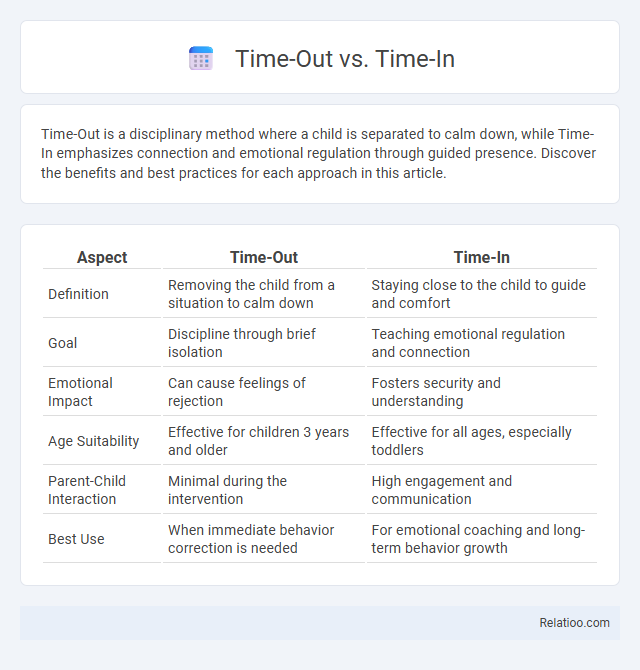Time-Out is a disciplinary method where a child is separated to calm down, while Time-In emphasizes connection and emotional regulation through guided presence. Discover the benefits and best practices for each approach in this article.
Table of Comparison
| Aspect | Time-Out | Time-In |
|---|---|---|
| Definition | Removing the child from a situation to calm down | Staying close to the child to guide and comfort |
| Goal | Discipline through brief isolation | Teaching emotional regulation and connection |
| Emotional Impact | Can cause feelings of rejection | Fosters security and understanding |
| Age Suitability | Effective for children 3 years and older | Effective for all ages, especially toddlers |
| Parent-Child Interaction | Minimal during the intervention | High engagement and communication |
| Best Use | When immediate behavior correction is needed | For emotional coaching and long-term behavior growth |
Understanding Time-Out and Time-In
Time-Out removes your child temporarily from a situation to help them calm down and reflect on their behavior, while Time-In involves staying close and guiding your child through emotions to promote emotional connection and understanding. Time-In supports emotional regulation by encouraging communication and empathy, whereas Time-Out focuses on boundary-setting and immediate behavioral correction. Implementing these strategies effectively requires recognizing when your child needs comfort versus when they need a clear pause to reconsider their actions.
Origins and Theories Behind Each Approach
Time-Out originated from behaviorist theories, particularly B.F. Skinner's operant conditioning, emphasizing removal from reinforcing stimuli to decrease undesirable behaviors. Time-In derives from attachment theory and emotional regulation research, promoting connection and co-regulation to build secure relationships and emotional awareness. Discipline strategies encompass a broader range of psychological frameworks, including social learning theory and cognitive development, aiming to guide behavior through consistent consequences and positive reinforcement.
Key Differences: Time-Out vs Time-In
Time-Out involves temporarily removing a child from a situation to calm down and reflect on behavior, emphasizing isolation and self-regulation, while Time-In focuses on staying connected with the child to understand emotions and guide positive behavior through empathy and support. Discipline strategies like Time-Out often prioritize consequences and behavior correction, whereas Time-In encourages relationship-building and emotional coaching. Understanding these key differences helps you choose an approach that aligns with your parenting goals and your child's emotional needs.
Psychological Impact on Children
Time-Out strategies often create feelings of isolation and can lead to increased anxiety or resentment in children, whereas Time-In approaches foster emotional connection and help children understand and regulate their feelings. Discipline strategies that emphasize positive reinforcement encourage self-discipline and promote healthy psychological development. Your choice of approach significantly influences a child's emotional well-being and long-term behavior patterns.
When to Use Time-Out Effectively
Time-Out is most effective when used immediately following a specific undesired behavior to create a clear association between the action and the consequence, ideally lasting one minute per year of the child's age to maintain attention without causing frustration. It serves best for behaviors driven by seeking attention or impulsive reactions rather than for situations demanding complex emotional understanding or teaching long-term skills, where Time-In or positive discipline strategies foster connection and guidance. Consistency, calm delivery, and clear communication about the reasons for Time-Out enhance its role as a controlled and structured response within a broader discipline framework.
Benefits of Time-In for Emotional Development
Time-In strategies promote emotional regulation by encouraging You to connect with Your child during moments of distress, fostering a secure attachment and enhancing empathy. Unlike Time-Out, which isolates, Time-In teaches self-awareness and coping skills by validating feelings and modeling calm behavior. This approach supports long-term emotional intelligence, helping children develop resilience and healthy relationship dynamics.
Common Misconceptions and Myths
Time-Out is often misunderstood as purely punitive, but it is designed to provide children a moment to calm down and reflect, not to punish; Time-In focuses on connection and teaching emotional regulation through empathy and communication rather than isolation. Discipline strategies frequently get confused with punishment; effective discipline aims to guide and teach appropriate behavior, contrasting with the myth that strict or harsh measures are necessary for compliance. Common misconceptions include the belief that Time-Out causes long-term emotional harm, while research shows that, when used correctly, both Time-Out and Time-In support healthy emotional development and behavior correction.
Integrating Discipline Strategies at Home
Integrating discipline strategies at home involves understanding the distinct roles of Time-Out, Time-In, and other discipline methods to foster positive behavior. Time-Out serves as a brief pause for reflection, while Time-In emphasizes emotional connection by guiding Your child through their feelings and providing support. Balancing these approaches helps build trust, promotes emotional regulation, and creates a nurturing environment conducive to long-term behavioral growth.
Expert Recommendations and Research Insights
Experts emphasize that time-in strategies, which involve positive reinforcement and emotional connection, are more effective than traditional time-outs for fostering long-term behavioral improvements in children. Research indicates that time-in techniques enhance a child's self-regulation and emotional intelligence by promoting understanding and empathy rather than isolation. Discipline strategies combining clear boundaries with supportive communication are recommended to balance accountability and emotional development.
Choosing the Right Approach for Your Child
Choosing the right discipline strategy for your child involves understanding the purpose of each method: time-out provides a break for calming down, time-in fosters emotional connection and communication, and broader discipline strategies guide behavior through consistent boundaries. Your choice should align with your child's temperament and specific behavioral needs to achieve effective results. Implementing a balanced approach that combines emotional support and clear consequences helps promote long-term positive behavior and healthy development.

Infographic: Time-Out vs Time-In
 relatioo.com
relatioo.com